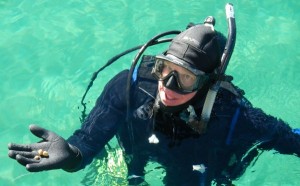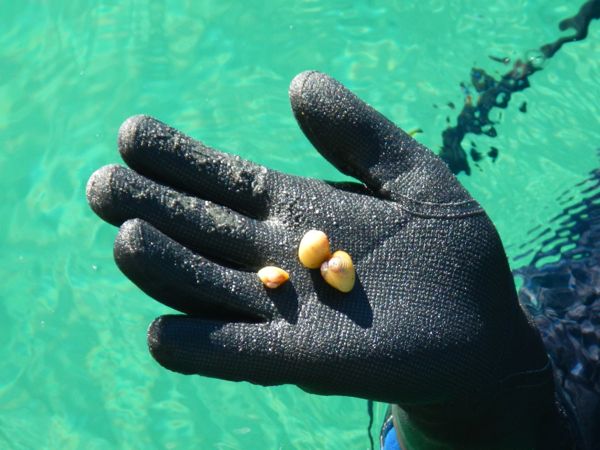Asian clams being suffocated to protect Emerald Bay
By Kathryn Reed
Asian clams are expected to always be a reality in Lake Tahoe. But an $810,000, yearlong project is under way to keep them from taking over Emerald Bay.
With it estimated that 95 percent of the people who launch a boat at Lake Tahoe make their way to Emerald Bay, keeping that inlet as pristine as possible is not only good for the environment, but for tourism – aka the economy.

Brant Allen brings up a handful of Asian clams -- the ones he is helping get rid of at Emerald Bay. Photos/Kathryn Reed
Excretion from the clams creates algae blooms, which makes the nearshore, or beach area, unappealing to swim in, look at or paddle over. The bay has about 10 acres of nearshore.
These are not clams one eats – mostly because it would take too long to get a forkful. They are about 2 to 3 centimeters, with some 1-2 millimeters – like a grain of sand.
Another reason to eliminate the Asian clams is that they produce calcium – which Lake Tahoe doesn’t naturally have much of. And calcium is needed for quagga mussels to survive and thrive. To date, that aquatic invasive specie has not turned up in Tahoe. It is the critter that has devastated Lake Mead in Southern Nevada.
Allison Gamble with the Tahoe Environmental Research Center said it will be impossible to ever eradicate the clams from Lake Tahoe, but controlling them and eliminating them from key locations are the goals.
The earliest recording of this invasive clam at Tahoe was 2002, but it took six years for them to be a problem. A year later, 2009, was when the Aquatic Invasive Species Program rolled out. This included boat inspections, which look for Asian clams. Most likely the clams arrived via a boat’s bilge.
While scientists know the Asian clams are in Donner Lake, they were surprised when told by a photographer with the Reno Gazette-Journal that she found some in the Truckee River. There is no monitoring program on the river.
Clam control
On Oct. 25 a team of divers began covering 5 acres at the mouth of Emerald Bay with a biomass material made of shredded aspen that is then covered with a rubber mat. The purpose is to smoother the clams. This is all being done in about 15-feet of water, with 25 feet being about the deepest.
Looking over a boat it’s easy to see the black covering the sand. Crews should be done placing the mats by the end of November. During this time boats may still access Emerald Bay, but there could be a bit of a delay if divers are in the water.
Brant Allen with UC Davis is one of those divers. On Tuesday he described it as an “exhausting day of work.” The mats that are rolled out by two divers weigh 300 pounds on land and not much less under water.
It takes about 30 minutes to unroll each mat. Two hundred thirty-eight mats need to be placed on the lake bottom. The project also includes 25 tons of rebar that cover 10 miles, and 17,000 rivets.
The goal is to suffocate the clams by extinguishing their oxygen supply. Scientists have access points to check the site on what will likely be a monthly basis until all of the material is removed a year from now.
They live just under the sand. When shells are visible, it means the clam is dead.
Other points of interest
Steve Chilton with the U.S. Fish and Wildlife Service said, “AIS is the largest threat to the ecosystem.”
Most of the clams are on the south end of the lake. Emerald Bay is the farthest point north and west they have been found.
“The economic impact of Emerald Bay to Lake Tahoe and the region cannot be overstated,” Dan Shaw, environmental scientist with California State Parks said. The bay is state parks land.
About 1,000 boats a day come into the bay on peak summer days. Shaw told Lake Tahoe News a camera was set up this summer to record the speed of boats, but because so many come through the mouth it was impossible to gather that data.
To pay for the project, California Water Board allocated $458,220 and $352,000 came from the Southern Nevada Public Lands Management Act. The latter source of funding will be exhausted in 2014, so where money will come from for future projects is an unknown.
(Click on photos to enlarge.)








Wonder how many locals are being used on this project. Almost a million dollars could sure help many local divers and dive teams in the area. Did this have to go out to bid?
Hi Bulababy,
Yes, using local businesses is a priority for the Lake Tahoe Aquatic Invasive Species Program whenever possible. Through a competitive bidding process, we used a local barge contractor and local research divers from UC Davis/Tahoe Environmental Research Center. We also use local divers for our invasive plant removal projects. Thanks for your interest. More information on the Lake Tahoe AIS Program can be found online at tahoeboatinspections.com and tahoekeepers.org.